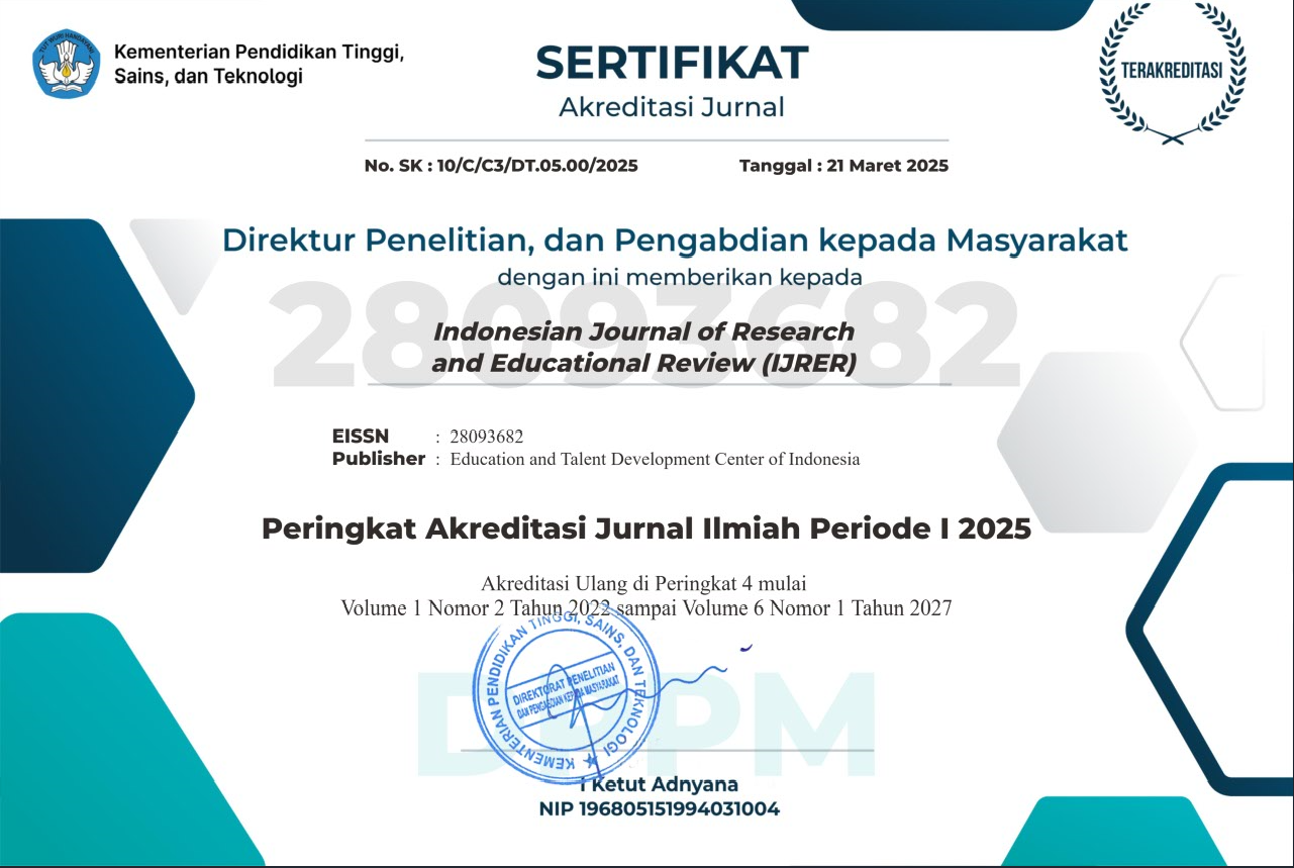Interactional Feedback on English Proficiency: Grammatical Awareness
DOI:
https://doi.org/10.51574/ijrer.v1i3.397Keywords:
English Proficiency, Grammatical Awareness, Interactional FeedbackAbstract
This study examines whether or not interactional feedback has a considerable positive impact on first-year MA Nurul As'adiyah Callacu students' grammatical awareness. The pre-experimental research method was used in the study. 38 grade X A students made up the sample. The research's pre- and post-test grammatical data were collected, and the t-test in SPSS was used to assess it. The study's findings showed a substantial difference between the students' levels of grammatical awareness on the pretest and posttest. The fact that the mean posttest score was greater than the mean pretest score (91.32 > 59.08) served as evidence. These mean scores were different in a statistically significant way. The probability value is lower than the significant level (0.00 < 0.05), which was based on the t-test value at the significant level of 0.05. Based on the result analysis, it can be said that interactional feedback significantly improved grammatical awareness in the first year of MA Nurul As'adiyah Callacu because it promoted learners' intellectual operations and thought processes, which led them to reflect on ideas, particularly in grammar learning.
References
Abdollahifam, S. (2014). Investigating the effects of interactional feedback on EFL students’ writings. Procedia-Social and Behavioral Sciences, 98, 16-21.
Biber, D., Gray, B., Staples, S., & Egbert, J. (2020). Investigating grammatical complexity in L2 English writing research: Linguistic description versus predictive measurement. Journal of English for Academic Purposes, 46, 100869. https://doi.org/10.1016/j.jeap.2020.100869
Brinkmann, J. L., Cash, C., & Price, T. (2021). Crisis leadership and coaching: a tool for building school leaders' self-efficacy through self-awareness and reflection. International Journal of Mentoring and Coaching in Education. https://doi.org/10.1108/IJMCE-01-2021-0009
Canale, M. (2014). From communicative competence to communicative language pedagogy. In Language and communication (pp. 14-40). Routledge.
Chen, J. C., & Kent, S. (2020). Task engagement, learner motivation and avatar identities of struggling English language learners in the 3D virtual world. System, 88, 102168. https://doi.org/10.1016/j.system.2019.102168
Demetriou, A., Kazi, S., Makris, N., & Spanoudis, G. (2020). Cognitive ability, cognitive self-awareness, and school performance: From childhood to adolescence. Intelligence, 79, 101432.
Hashemifardnia, A., Namaziandost, E., & Sepehri, M. (2019). The effectiveness of giving grade, corrective feedback, and corrective feedback-plus-giving grade on grammatical accuracy. International Journal of Research Studies in Language Learning, 8(1), 15-27. https://papers.ssrn.com/sol3/papers.cfm?abstract_id=3463040
Hudgens Henderson, M. (2022). Critical Language Awareness in the Spanish as a Heritage Language College Classroom. Languages, 7(3), 157.
Kaharuddin, A. (2018). The communicative grammar translation method: a practical method to teach communication skills of English. ETERNAL (English, Teaching, Learning, and Research Journal), 4(2), 232-254.
Kaivanpanah, S., Alavi, S. M., & Sepehrinia, S. (2015). Preferences for interactional feedback: differences between learners and teachers. The Language Learning Journal, 43(1), 74-93.
Kasper, G., & Wagner, J. (2018). Epistemological reorientations and L2 interactional settings: A postscript to the special issue. The Modern Language Journal, 102, 82-90. https://doi.org/10.1111/modl.12463
Larsen-Freeman, D., & DeCarrico, J. (2019). Grammar. In An introduction to applied linguistics (pp. 19-34). Routledge. https://doi.org/10.4324/9780429424465-2
Larsen-Freeman, D. (2019). Teaching and researching grammar skills: Theory-and research-based practices. In Research-driven pedagogy (pp. 97-124). Routledge.
Leacock, C., Chodorow, M., Gamon, M., & Tetreault, J. (2010). Automated grammatical error detection for language learners. Synthesis lectures on human language technologies, 3(1), 1-134. https://doi.org/10.2200/S00275ED1V01Y201006HLT009
Leech, G., Hundt, M., Mair, C., & Smith, N. (2009). Change in contemporary English: A grammatical study. Cambridge University Press.
Mackey, A., Gass, S., & McDonough, K. (2000). How do learners perceive interactional feedback?. Studies in second language acquisition, 22(4), 471-497.
Mahmood, R. K. (2019). The Dissolution of linguistics and the rise of language with reference to pragmatics: A deconstructive approach. Journal of University of Human Development, 5(3), 1-5. https://doi.org/10.21928/juhd.v5n3y2019.pp1-5
Majlesi, A. R. (2018). Instructed vision: Navigating grammatical rules by using landmarks for linguistic structures in corrective feedback sequences. The Modern Language Journal, 102, 11-29. https://doi.org/10.1111/modl.12452
Nassaji, H. (2020). Assessing the effectiveness of interactional feedback for L2 acquisition: Issues and challenges. Language Teaching, 53(1), 3-28. https://doi.org/10.1017/S0261444819000375
Nurullayevna, S. N. (2021). The techniques of explicit grammar instruction. Middle European Scientific Bulletin, 12, 281-284. http://cejsr.academicjournal.io/index.php/journal/article/view/549
Puchta, H. (2018). Teaching grammar to young learners. In The Routledge Handbook of Teaching English to Young Learners (pp. 203-219). Routledge.
Rankin, T., & Whong, M. (2020). Grammar: A Linguists' Guide for Language Teachers. Cambridge University Press.
Rassaei, E., & Moinzadeh, A. (2011). Investigating the Effects of Three Types of Corrective Feedback on the Acquisition of English Wh-Question Forms by Iranian EFL Learners. English Language Teaching, 4(2), 97-106. https://doi.org/10.5539/elt.v4n2p97
Reynolds, B. L., & Kao, C. W. (2021). The effects of digital game-based instruction, teacher instruction, and direct focused written corrective feedback on the grammatical accuracy of English articles. Computer Assisted Language Learning, 34(4), 462-482.
Russell, J., & Spada, N. (2006). The effectiveness of corrective feedback for the acquisition of L2 grammar. Synthesizing research on language learning and teaching, 13, 133-164.
Saaristo, P. (2015). Grammar is the heart of language: grammar and its role in language learning among Finnish university students. Voices of pedagogical development–Expanding, enhancing and exploring higher education language learning, 279-318.
Sato, T., Yujobo, Y. J., Okada, T., & Ogane, E. (2019). Communication strategies employed by low-proficiency users: Possibilities for ELF-informed pedagogy. Journal of English as a Lingua Franca, 8(1), 9-35. https://doi.org/10.1515/jelf-2019-2003
Seidenberg, M. S., & MacDonald, M. C. (2018). The impact of language experience on language and reading. Topics in Language Disorders, 38(1), 66-83.
Shumin, K. (2002). Factors to consider: Developing adult EFL students’ speaking abilities. Methodology in language teaching: An anthology of current practice, 12, 204-211.
Taumoepeau, M., & Ruffman, T. (2016). Self-awareness moderates the relation between maternal mental state language about desires and children’s mental state vocabulary. Journal of experimental child psychology, 144, 114-129. https://doi.org/10.1016/j.jecp.2015.11.012
Wolde, V. (2021). phonological, morphological or morpho-syntactic form is studied on. In Narrative Syntax and the Hebrew Bible: Papers of the Tilburg Conference 1996 (p. 21). BRILL.









1.png)













